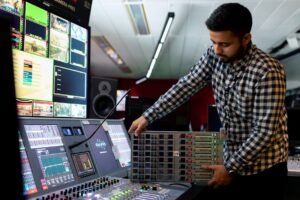Generative Audio Visual – An Unorthodox Blend of Art and Sound
Generative audio visual is an emerging art form that combines visual elements with dynamic soundscapes to create interactive and immersive experiences. It is a creative process that utilizes algorithms, data, and real-time input to generate unique audio visual content. Through the manipulation of various parameters and rules, artists and designers can create dynamic and continuously evolving compositions that stimulate multiple senses simultaneously.
Key Takeaways
- Generative audio visual is an innovative art form that blends visuals and sounds using algorithms and real-time input.
- It allows artists to create interactive and immersive experiences that engage multiple senses.
- The use of parameters and rules enables compositions to evolve and change over time.
Generative audio visual works on the principle of using algorithms and rules to define the behavior and characteristics of visual and auditory elements. These algorithms can be deterministic or stochastic, providing either precise or random results, respectively. By introducing different variables and defining various relationships, artists can manipulate and control the generative process. This approach allows for endless possibilities and the creation of complex and dynamic audio visual compositions. It’s like giving art a life of its own.
In generative audio visual, visuals and sounds are closely intertwined. Visual elements can be created using programming languages or dedicated software tools, while audio elements can be synthesized or sampled. By linking the visual and auditory parameters, changes in one domain can affect the other, enabling a seamless integration that heightens the overall experience. The interaction between the audio and visual components can occur in real-time or be pre-determined, providing artists with complete control over the composition. The result is a synesthetic experience that stimulates both the eyes and the ears.
The Science Behind Generative Audio Visual
- The generative process in audio visual art involves the use of algorithms and data.
- Algorithms define the rules and behavior of the audio and visual elements.
Generative audio visual relies on algorithms to define the rules and behavior of the art piece. These algorithms can be based on complex mathematical formulas or simple logical conditions. The use of data, such as real-time input or pre-recorded information, can further influence the generative process. By programming the algorithms to respond to specific triggers or stimuli, the artist can create interactive experiences that dynamically adapt to the environment or user input. This allows for endless variations and an element of unpredictability.
The output of the generative audio visual process can take various forms, from static compositions to live performances. In live performances, the artist often engages in improvisation, manipulating the parameters in real-time to respond to the atmosphere or the audience. This interplay between the generative system and the artist’s creative input adds a layer of human expression to the artwork. Generative audio visual is an art form that continuously evolves and adapts, never ceasing to surprise and captivate.
| Benefits of Generative Audio Visual |
|---|
| Enables the creation of unique and dynamic compositions |
| Enhances the engagement and immersion of the audience |
| Allows for infinite variations and possibilities |
The Future of Generative Audio Visual
The future of generative audio visual holds great promise. As technology continues to advance, the tools and techniques used to create generative art will become more accessible and sophisticated. Artists and designers will have even greater control and flexibility in shaping their audio visual experiences. Additionally, the integration of generative processes with emerging technologies such as virtual reality and artificial intelligence opens up new realms of creative possibilities. Generative audio visual is poised to revolutionize the way we perceive and interact with art.
| Applications of Generative Audio Visual |
|---|
| Art exhibitions and installations |
| Live performances and concerts |
| Interactive experiences |
Generative audio visual is a rapidly evolving field that pushes the boundaries of traditional art forms. It combines the power of algorithms, data, and real-time input to create mesmerizing compositions that blend visuals and sounds in harmony. With its ability to engage multiple senses and create interactive experiences, generative audio visual is transforming the way we perceive and appreciate art. Whether in art exhibitions, live performances, or interactive installations, generative audio visual captivates and inspires, creating a truly immersive and transcendent experience. Prepare to be amazed by the unorthodox and captivating world of generative audio visual.

Common Misconceptions
Generative Audio Visual
One common misconception about generative audio visual is that it is purely a form of entertainment. While it can certainly be enjoyed for its aesthetic appeal and immersive experience, generative audio visual is also used in various practical applications. Some examples include data visualization, scientific simulations, and interactive art installations.
- Generative audio visual can be used for educational purposes, helping to explain complex concepts visually.
- Many architects and urban planners use generative audio visual techniques to visualize and model their designs before construction begins.
- Generative audio visual can also be employed in therapy and rehabilitation settings to provide engaging and stimulating experiences for patients.
Another common misconception is that generative audio visual art requires advanced technical skills and knowledge. While proficiency in programming and multimedia software can certainly enhance the creative process, there are user-friendly tools and platforms available that allow artists and enthusiasts to create generative audio visual works without extensive coding expertise.
- Online platforms like Processing and Max/MSP provide accessible interfaces for creating generative art and music.
- Various mobile apps offer simplified generative audio visual tools for users to explore and experiment with.
- Even without programming, artists can utilize pre-built generative audio visual software and modify existing templates to suit their creative vision.
It is also commonly misunderstood that generative audio visual works lack originality and creativity. However, generative audio visual is inherently based on algorithms and rules that can be manipulated and customized to produce unique and innovative visual and auditory experiences. Artists and creators have the ability to shape and influence the generative process, resulting in distinctive and one-of-a-kind outcomes.
- Generative audio visual allows artists to create dynamic and evolving artworks that respond to various inputs or conditions.
- The use of generative algorithms opens up vast creative possibilities, enabling artists to explore new aesthetics and aesthetics.
- Artists can experiment with different parameters, randomness, and rules within the generative process to achieve original and surprising results.
There is often a misconception that generative audio visual is only accessible to tech-savvy individuals. While a technical background can certainly help in the creation and understanding of generative audio visual works, there are numerous resources available for beginners to learn and explore this medium. Online tutorials, workshops, and communities provide valuable guidance and support for individuals interested in diving into the world of generative audio visual.
- Online forums and communities provide a platform for beginners to seek advice, share their work, and learn from experienced practitioners.
- Textbooks and online courses offer step-by-step guidance for learning the fundamentals of generative audio visual creation.
- Generative audio visual artists often host workshops and exhibitions to introduce newcomers to the medium and inspire their creativity.
Finally, some may mistakenly believe that generative audio visual artwork is created through a completely automated process without any human intervention. While the algorithms and rules define a significant portion of the generative process, artists still play a crucial role in shaping and guiding the output. They make deliberate decisions on parameters, aesthetics, and overall composition, ensuring that the generative artwork aligns with their artistic vision.
- Artists often develop their own algorithms or modify existing ones to generate unique and personalized results.
- Through iterative exploration and experimentation, artists actively refine and fine-tune the generative audio visual process.
- Generative audio visual art requires artists to strike a balance between control and surrendering some creative control to chance and emergent behaviors.

Generative Audio Visual
Generative audio visual refers to the creation of multimedia content that evolves and reacts in real time based on a set of predefined rules or algorithms. It combines audio and visual elements to create immersive and interactive experiences. In this article, we explore various aspects of generative audio visual with a series of captivating tables that showcase its applications and impact.
Evolution of Generative Audio Visual
The following table illustrates the timeline of key advancements in generative audio visual:
| Year | Milestone |
|——|——————————|
| 1968 | First computer-generated art |
| 1986 | Mark Fell’s audio-visual |
| 1992 | Visual music software |
| 2001 | Karl Sims’ evolving forms |
| 2009 | Processing software |
Applications of Generative Audio Visual
This table showcases some of the diverse applications of generative audio visual:
| Application | Description |
|———————–|————————————————————|
| Live performances | Real-time creation of audio-visual experiences |
| Installations | Interactive multimedia installations in physical spaces |
| Virtual reality | Immersive experiences through interactive virtual worlds |
| Advertising | Dynamic and engaging visual and audio campaigns |
| Data visualization | Exploring patterns and insights through generative visuals |
| Games | Adaptive and responsive audio-visual game experiences |
| Artistic expression | Creative exploration of generative audio-visual concepts |
| Education | Interactive learning experiences through multimedia |
| Therapy and wellness | Relaxation and mindfulness applications through visuals |
| Architectural design | Enhancing spaces with dynamic audio-visual elements |
Impact of Generative Audio Visual
This table highlights the positive impact of generative audio visual on various industries:
| Industry | Impact |
|——————-|————————————————————————————————————————————–|
| Entertainment | Enhanced audience engagement and immersion |
| Art | New creative possibilities and exploration of generative techniques |
| Science | Visualization and understanding of complex data sets |
| Technology | Advancements in interactive multimedia and virtual reality technologies |
| Education | Interactive and dynamic learning experiences |
| Advertising | Captivating and memorable multimedia campaigns |
| Healthcare | Therapeutic and wellness applications through audio-visuals |
| Architecture | Integration of dynamic and responsive audio-visual elements in design |
| Gaming | Adaptive and personalized gaming experiences |
| Visual effects | Creation of stunning and realistic visual effects in films and video games |
The use of generative audio visual has revolutionized multiple industries, enabling interactive and dynamic experiences that captivate audiences. Whether in entertainment, art, education, or healthcare, the impact of generative audio visual is vast and continues to expand, leading to new creative possibilities and enhanced engagement.
Frequently Asked Questions
1. What is generative audio visual?
Generative audio visual refers to the creation of multimedia content, typically combining sound and visuals, that is produced using algorithms and predefined rules. This approach allows for the creation of dynamic and evolving audio visual experiences.
2. How does generative audio visual work?
Generative audio visual works by using algorithms and rules to control the creation and manipulation of sound and visual elements. The algorithms can generate or modify content in real-time based on various factors such as user input, sensor data, or randomization techniques.
3. What are some applications of generative audio visual?
Generative audio visual can be applied in various fields, such as art, music, gaming, data visualization, and interactive installations. It can be used to create immersive experiences, interactive artworks, dynamic visuals for performances, and more.
4. What programming languages are commonly used in generative audio visual?
Some programming languages commonly used in generative audio visual include JavaScript, Python, Max/MSP, Pure Data, Processing, and Unity. These languages provide frameworks and libraries that facilitate the generation and manipulation of audio visual content.
5. What tools and software can I use to create generative audio visual?
There are several tools and software available for creating generative audio visual content. Some popular examples include Max/MSP, Pure Data, Processing, Unity, TouchDesigner, and openFrameworks. These tools provide a range of functionalities and visual programming environments to assist in creating generative audio visual experiences.
6. Can generative audio visual content be interactive?
Yes, generative audio visual content can be interactive. By incorporating user input, such as gestures, triggers, or sensors, the content can respond and adapt in real-time. This interactivity enhances the user’s engagement and allows for unique and personalized experiences.
7. Are there any notable artists or projects in the field of generative audio visual?
Yes, there are several notable artists and projects in the field of generative audio visual. Some examples include Ryoji Ikeda‘s audio-visual installations, Robert Henke’s laser and sound performances, Refik Anadol’s data-driven installations, and Casey Reas’ interactive artworks. These artists push the boundaries of generative audio visual through innovative techniques and concepts.
8. Can generative audio visual content be integrated into live performances?
Absolutely. Generative audio visual content can be seamlessly integrated into live performances, such as concerts, theater productions, and multimedia events. The real-time generation and manipulation capabilities allow for dynamic visuals that synchronize with the live performance, creating visually captivating and immersive experiences.
9. What are the benefits of using generative audio visual?
The use of generative audio visual offers several benefits. It allows for the creation of unique and ever-evolving content, as well as customization based on user input. It pushes the boundaries of traditional static visuals and enhances audience engagement. Additionally, it fosters experimentation and opens up new creative possibilities in the field of multimedia art and performance.
10. Can generative audio visual content be experienced online?
Yes, generative audio visual content can be experienced online. Artists and developers often showcase their generative audio visual projects on websites or platforms dedicated to displaying interactive and immersive content. Some projects can even be experienced through web-based applications, allowing users to engage with generative audio visual experiences directly from their browsers.




